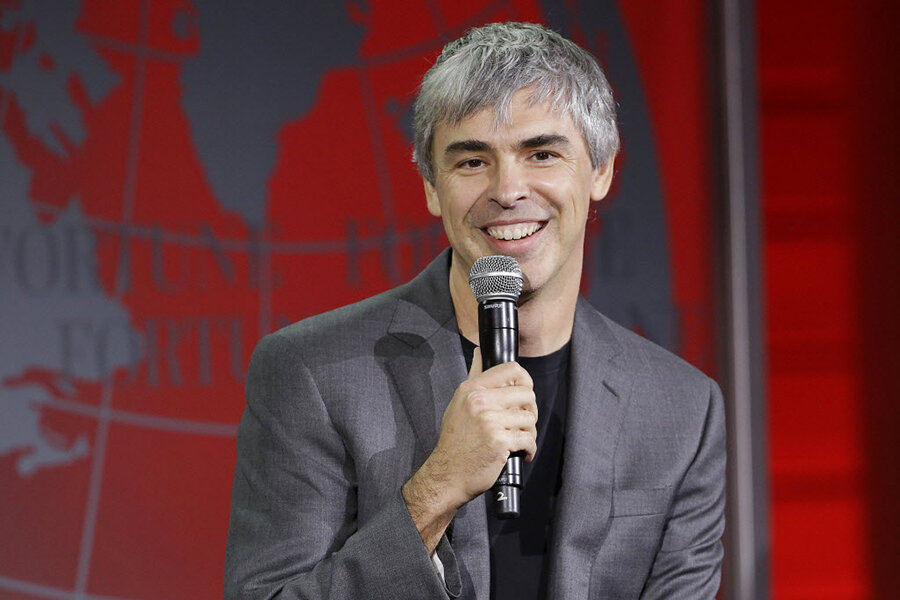Why is Google's co-founder secretly investing in flying cars?
Loading...
In the 20th century, the idea of a flying car was often thought of as a sci-fi trope, restricted to the cartoon series "The Jetsons" or the 80s cult hit "Repo Man," where the bodies of aliens caused a vintage Chevy Malibu to shoot straight up in the air.
But a growing number of companies have increasingly been working to make flying cars a reality, including two California startups that have been backed, secretly, by Google co-founder Larry Page, according to a Bloomberg report published Thursday.
According to the report, Mr. Page has personally funded Zee.Aero, a mysterious startup working on a flying car near Google’s headquarters in Mountain View, Calif., since 2010. Last year, he began funding a second start-up, Kitty Hawk.
In Silicon Valley, flying cars have occasionally been a punchline. "We were promised flying cars, and instead what we got was 140 characters," is the motto of an investment firm founded by venture capitalist Peter Thiel, poking fun at Twitter.
But researchers say that, as with self-driving cars, advances in autonomous technology mean that the idea of a flying car is no longer an abstraction.
"I think it's so hilarious that this whole thing is just starting to make news, I kind of want to line people up and slap them and say, 'Where have you been people, this has been going on for years,'" Mary Cummings, an associate professor at Duke University who directs the university's Humans and Autonomy Lab, tells The Christian Science Monitor in a phone interview.
California-based Joby Aviation, AeroMobil, Lilium Aviation, and Terrafugia, a Massachusetts-based startup, have already begun building prototypes. The Chinese firm EHang, Professor Cummings notes, recently partnered with the state of Nevada to begin testing a "drone taxi" that transports a passenger for up to 23 minutes.
But there are still significant concerns to be worked out, including how much the drones will cost and how they will be regulated by the Federal Aviation Administration.
"Silicon Valley is full of secret projects: Flying cars are almost quaint by comparison (since people have been proposing them for decades)," Bryant Walker Smith, an assistant professor at the University of South Carolina School of Law who studies the technology, tells the Monitor in an email. "They will raise pretty significant environmental and equity concerns."
While the motivations for Page's project may be, in part, fulfilling what seems like an impossible dream, the companies also say their projects could help redefine transportation.
"The goal is to build a product that impacts the lives of lots of people," Paul Sciarra, a co-founder of photo-sharing site Pinterest who has backed Joby Aviation, told Bloomberg. "Not just folks that are amateur pilots or wealthy, but everyone."
Even Lockheed-Martin, the aerospace giant, has been developing an unmanned, autonomous flying vehicle to deliver supplies and people.
It has received funding from DARPA, the Pentagon's research arm, which played a key role in the development of self-driving cars, hosting a series of research contests in the mid-2000s. The company didn't respond to a request for comment from the Monitor.
Citing eyewitness reports, Bloomberg says there may be two different Zee.Aero vehicles that both feature "a narrow body, a bulbous cockpit with room for one person upfront and a wing at the back." Kitty Hawk, by contrast, is reportedly working on "something that resembles a giant version of a quadcopter drone."
The project is highly secretive, with a former colleague telling Bloomberg that Page once threatened to back out of the startups if his involvement became public. He's reported to have invested more than $100 million in the effort.
Other companies have provided more details. Terrafugia, which was founded in 2006, says its TF-X would be priced similarly to "high-end luxury cars" and could go into production in the next eight to 12 years.
It was also an early leader in another thorny area: getting permission to actually make a flying car available, says Professor Smith. Currently, companies need permission from both the National Highway Transportation Safety Administration and the FAA.
"Terrafugia … actually asked both agencies for specific regulatory exemptions, because complying with both sets of requirements was either technically impossible or economically impractical," Smith explains. "If a car is too heavy, it may have bad fuel efficiency. But if a plane is too heavy, it won't even get off the ground!"
But Dr. Cummings, who has been researching drones for 14 years, says the FAA's policies have remained far behind the technology. The agency is currently struggling with regulating consumer uses of drones and modernizing air traffic control; it only began "begrudgingly" considering commercial uses of drones in 2013, when Amazon introduced plans for its Prime Air delivery service, she says.
"If it weren't Amazon jumping in here with Prime Air, even with the political pressure and the business opportunities, [the FAA is] really dragging their feet to make this happen, and that's why we’re losing our edge in the US," she says.
But with efforts to develop flying cars and autonomous drones further, she says, "I do think it's changing, the news is not all bad."







